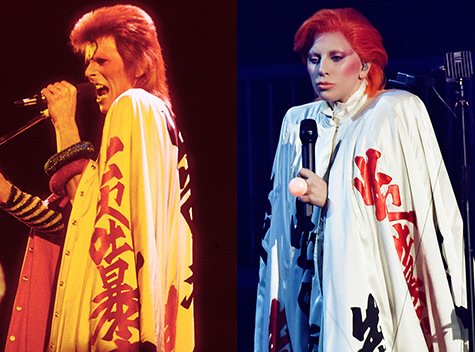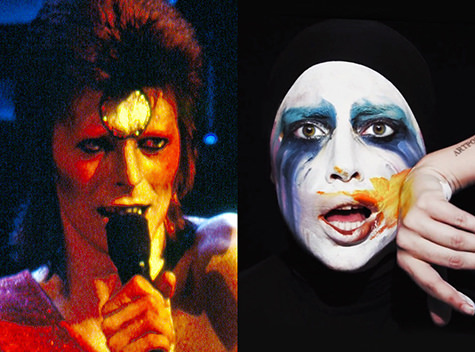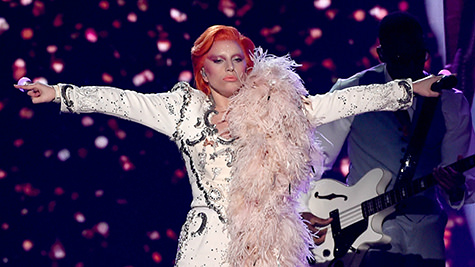Audiovision: David dead & sounding real
Philip Brophy: Lady Gaga’s David Bowie Tribute, 58th Annual Grammys
The death of any stellar figure in rock and pop’s pantheon of propped-up puppets instigates numerous public relations crises. Most entail pseudo-ethical means of exploiting while commemorating, honouring the star’s passing while recouping long-term investment in their career. This is entirely acceptable: rock and pop stars work within an industry. Fawning outrage over their post-mortem commercialism is disingenuous. Far more offensive is the angsting over how one should respectfully acknowledge their legacy.
The post-mortem hagiography of David Bowie is a salient demonstration of this irksome moralising over the assignation of tributes to his audiovision. Out from the damp chipboard of rock and pop’s image-hoarding crept a gaggle of singer-songwriters on whom the industry could confer the temporary crown for voicing their respect to their fallen gladiator of Glam. The uppermost echelon of this hustling tower of pop Babel is the Grammys. What worldly—nay, universal—responsibility the chosen performer will carry upon his or her Olympian shoulders. Who would have thought so many people would come to bury David Bowie?
Bowie had been preparing himself for erasure from the world of rock and pop for quite some time. The most recent signs were managerial. From his incorporation of economic selfhood via the securitising of bonds signed with his name-brand to the start of near-death lyrical projections with Hours (1997), to the projective haunting symbolically threaded through the musical Lazarus (2015, with playwright Enda Walsh) and his final albums The Next Day (2015) and Blackstar (2016). But the early signs were theatrical. He killed off the fictional Ziggy Stardust in his tacky messianic narrative of The Rise And Fall Of Ziggy Stardust & The Spiders From Mars (1972)—a great-sounding proto-Glam hyper-electric album, but textually on par with a Ken Russell script. Then not too long afterwards on his 1974 US tour, he ditched the mash-up of Broadway showbiz glitz and wannabe-Burroughs dystopianism for the staging of Diamond Dogs (1974)—possibly Bowie’s best album despite its literary portentousness. Halfway through the tour and embattled by frightfully expensive logistics, Bowie radically reduced the staging. The concerts are documented on the second worst live double-album ever released: David Live (1975). (The worst? David Bowie’s Stage, 1978.) The only saving grace of this debacle is the weird image Bowie crafted, dressed in a baby blue zoot suit and vibrant Henna-red hair combed back like an androgynous 50s delinquent. Most of the concert photos from the tour are fuzzy and indistinct, contradicted by harsh arc-spot lighting. Did Lady Gaga think similarly when she chose to reference this look for her live tribute performance on the Grammys?

Lady Gaga, Grammys performance
Let’s do the semiotics. In his original get-up, Bowie looked like a white bayou ghost of James Brown made up like Marlene Dietrich and wearing a stage outfit stolen from The Stylistics. He dreamt he was all three Staples Singers rolled into one, but as evidenced on David Live, he sounded like Foghorn Leghorn doing Rufus Thomas. In her haute-couture homage, Lady Gaga colours her shoulder-padded suit white and adds some naff brocade. I’m sorry, but she looks like a squat theatre student doing drag king cosplay of Lt Gay Ellis from Gerry & Sylvia Anderson’s UFO (1970). But bizarrely, she sounds like Bowie on David Live: hoarse, dull, barking. Watching her performance initially was a cringeworthy experience. Then I remembered how woeful David Live is. At the time of that album’s release, it dawned on me that despite all the great momentary fragments, images and poses, Bowie left a trail of embarrassing tchotchkes. That’s how Bowie’s career panned out: a long line of stunning fake gems threaded onto long stretches of plastic barbed wire. Was this what Lady Gaga was honouring? Was this what the Grammys came to mourn?
Within America’s post-70s over-therapied self-obsessed culture, all successful rock and pop music intent on flaunting ‘newness’ seems equally bent on facilitating plurality and eclecticism for its populace. Maybe it starts with Alice Cooper. One can easily draw a low-brow suburban through-line from him to Marilyn Manson to Insane Clown Posse to Lady Gaga. They all psycho-babble about society, tribes, identity, self, expression, communality, difference and reflection. Bowie’s long-standing fascination with reflecting the sci-fi decay of the United States (from “Panic In Detroit” to “Fame” to “Black Out” to “Fashion” to “This Is Not America” to “Day In Day Out” to “I’m Afraid Of Americans”) formed a tacit backdrop for the staging of these recording artists. Consequently, Lady Gaga has over the last decade succeeded in being a quasi-feminist version of this anthropological averment of Otherness. It has been curious to witness her strategy limp forward: riffing off Madonna’s sampling of Abba’s “Gimme Gimme Gimme” (1975) for her hit “Hung Up” (2005) while performing tacky pantomime interpretations of Matthew Barney’s deluded follies. Essentially Billy Joel in Rocky Horror drag, Lady Gaga’s songwriting displaces her from Madonna’s trajectory, which always aimed for a hedonistic utopian nexus between Warhol’s Studio 54 and Sondheim’s Broadway. So despite all that feels wrong about her initially, Lady Gaga is the logical successor to the American reconstruction of David Bowie.

Lady Gaga, Grammys performance
While I entertain the perversion that Gaga and Barney are the Siegfried and Roy of desperately modish contemporary culture, Lady Gaga’s David Bowie Tribute for the 58th Annual Grammys was more pathetically Las Vegas than I could have imagined. It starts off with her in close-up, holding still while murmuring “Space Oddity” as facial-mapped animation is projected on her face. It’s as artful as an aisle in K-Mart selling Venetian masks. This is but one ‘hi-tech’ feature of her Intel-sponsored showcase.
Released online simultaneously is an embarrassing documentary showing the overwrought ‘creativity’ behind-the-scenes that resulted in the Grammys’ flaccid live televisual event. Following her Smartphone booth intro of ‘technology placement,’ Gaga the performer bursts forth with a 20-piece show band. What follows is a frenetic overture compacting eight Bowie hits into undifferentiated musical drivel: “Changes,” “Ziggy,” “Suffragette City,” “Rebel, Rebel,” “Fashion,” “Fame,” “Let’s Dance,” “Heroes.” Even though the band boasts Nile Rogers, it’s on par with the Paul Shaffer Band from Letterman’s Tonight Show. For six minutes, we hear nothing but predictably professional playing and alarmingly anaemic arrangements. The sound is numbing, typical of contemporary instruments, amps and FX being corralled into a thin, amplified reality. The implicit ideology behind this televisual aesthetic desires to counter ‘studio trickery’ with the direct sound of ‘real players’ with ‘real instruments.’ It always sounds lame and insipid, by attempting to suppress the aural transfiguration unleashed by the studio’s laboratory environment. This is why Stage sonically sucks: hearing all those unworldly anacoustic songs from Low, Heroes and The Lodger played by session musos through bad stage acoustics. David Live is the sound of Glam dying right before your ears. Weirdly, Intel’s sponsorship attempted to claim the opposite. The ridiculous robotic piano stand (about as thrilling as watching the robot Twiki dance from Buck Rogers in the 25th Century [1980]), and the downright stupid Curie Ring™ (a glorified Bluetooth mouse which generated facile trail-graphics on screens behind the singer) were meant to unleash unimaginable creativity. Gaga’s frenetic, flailing live performance perfectly captured this contradiction, because its live sound reinforced the obvious: David Bowie is dead.

Lady Gaga, Grammys performance
–
Lady Gaga, David Bowie Tribute, 58th Annual Grammys, 2016
RealTime issue #132 April-May 2016, web






